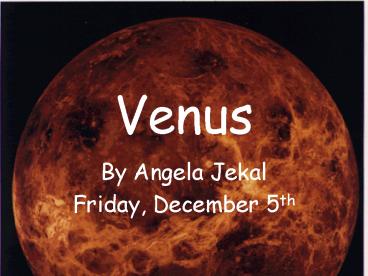Venus - PowerPoint PPT Presentation
1 / 12
Title:
Venus
Description:
This leads to the following question: If Venus is so similar to Earth, can it support life? ... characteristics prove that Venus cannot support life. Brightness ... – PowerPoint PPT presentation
Number of Views:1122
Avg rating:3.0/5.0
Title: Venus
1
Venus
- By Angela Jekal
- Friday, December 5th
2
Venus Earths Sister Planet
- Venus and Earth are both terrestrial planets
- Venus is only slightly smaller than Earth (95 of
Earth's diameter, 80 of Earth's mass - Venus surface gravity and average density is
close to Earths - Both have craters that indicate young surfaces
- Both have similar chemical compositions
- This leads to the following question If Venus is
so similar to Earth, can it support life?
3
Differences between Venus and Earth
- Closer to the Sun
- Much more heated
- Virtually waterless
- Thick, dense atmosphere
- Thick cloud layer of sulfuric components
- Makes Venus very difficult to learn about
- All these characteristics prove that Venus
cannot support life
4
Brightness
- At brightest, Venus is 16 times brighter than
the brightest star, only outshone by the moon and
the sun - Oftentimes it is called the evening star or the
morning star - Reasons
- - big size (about Earth-size)
- - proximity to the Sun
- - proximity to the Earth
- - reflects 59 of the sunlight that falls on
the planet
5
Motion
- Venus rotates very slowly one sidereal
- period takes 243 days, which is longer
- than its orbital period around the sun
- It is believed that Venus lacks a
- magnetic field because of its slow prograde
rotation - rotation
- Venus spins on its axis in retrograde
- rotation, where the planet rotates in
- the opposite direction in which it orbits
- the sun
- retrograde rotation
6
The Terrain
- Volcanism leads scientists to believe
- that Venus has a molten interior
- Venus has the most volcanoes of all the
- planets in the solar system over 1600
- volcanoes are mapped, but there may be
- about 100,000 to a million volcanoes
- pancake volcanoes
7
- Not much elevation contrast
- Highlands
- Ishtar Terra
- Highest point on Venus Maxwell Montes
- Aphrodite Terra
- Biggest land feature on Venus
- Wraps around 16,000 km around equator
- 2,000 km wide
- Craters
- There are about a thousand craters,
- which tells us Venuss surface is relatively
young
8
The atmosphere and the Greenhouse Effect
- The atmospheric pressure is 90 times that of
Earth - Venus has a thick cloudy layer of sulfur
components from volcanic activity - The atmosphere is 96.5 CO2, a major greenhouse
gas - Venus suffered from Runaway Greenhouse Effect
9
(No Transcript)
10
Exploring Venus
- Mariner 2
- First close flyby in 1962
- Measured radiation with microwaves of wavelengths
1.35 cm and 1.9 cm - Venera 7
- Transmitted data by 1970 by the Soviet Union
- First to descend into the atmosphere
- Discovered the exact 460ºC (860ºF) surface
temperature - Discovered the atmospheric pressure to be 90
times the atmospheric pressure on Earth - Magellan
- Went into orbit in 1990
- Mapped out 98 of the planet and over 1600
volcanoes - Provides our most detailed images thusfar
11
Venus is Interesting!
- Almost all terrain features of Venus are named
after female figures in history or legend - Galileo disproved the Ptolemaic system by
observing the moonlike phases of Venus - Solar transit will happen on June 8, 2004 and
June 6, 2012 the last two times this happened
was in 1874 and 1882
12
Bibliography
- Freedman, R. Kaufman, W. (2002). Universe.
New York W.H. Freeman and Company. - http//imagine.gsfc.nasa.gov/docs/ask_astro/answer
s/981026a.html - http//www.nasm.si.edu/ceps/etp/venus/
- http//www.reachoutmichigan.org/funexperiments/age
subject/lessons/images/diagrampage.html - http//seds.lpl.arizona.edu/nineplanets/nineplanet
s/pxvenus.html - http//spacelink.msfc.nasa.gov/Instructional.Mater
ials/Curriculum.Support/Space.Science/Our.Solar.Sy
stem/Venus/ - http//www.spaceweather.com/planets/gallery_07may0
3.html - http//volcano.und.nodak.edu/vwdocs/planet_volcano
/venus/intro.html































